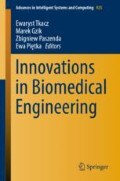Abstract
A study on voice fatigue evaluation is presented in this paper. It concerns the problem of vocal apparatus disorders with a general goal in the computer-assisted proper voice emission teaching support and possible disorder diagnosis. The singing and speech samples provided by 20 singers were recorded before and after a two-hour exhaustive performance. Nine features were extracted from each recording. Each feature was subjected to a statistical analysis using principal component analysis and Wilcoxon test producing feature importance ranking and individual p-values. Finally, a support vector classifier was employed for voice fatigue detection in separate singing and speech experiments, yielding assessment accuracies at 62.9% and 70.9%, respectively. The speech signal proved to reflect the voice fatigue more reliably than singing.
Access this chapter
Tax calculation will be finalised at checkout
Purchases are for personal use only
References
Lancer, J.M., Syder, D., Jones, A.S., Le Boutillier, A.: Vocal cord nodules: a review. Clin. Otolaryngol. 13(1), 43–51 (1988)
Yano, J., Ichimura, K., Hoshino, T., Nozue, M.: Personality factors in pathogenesis of polyps and nodules of vocal cords. Auris Nasus Larynx 9(2), 105–110 (1982)
Brodnitz, F.S., Froeschels, E.: Treatment of nodules of vocal cords by chewing method. AMA Arch. Otolaryngol. 59(5), 560–565 (1954)
Holmberg, E.B.: Efficacy of a behaviorally based voice therapy protocol for vocal nodules. J. Voice 15(3), 395–412 (2001)
Yiu, E.M.L., Wang, G., Lo, A.C.Y., Chan, K.M.K., Ma, E.P.M., Kong, J., Barrett, E.A.M.: Quantitative high-speed laryngoscopic analysis of vocal fold vibration in fatigued voice of young karaoke singers. J. Voice 27(6), 753–761 (2013)
Woo, P., Colton, R., Casper, J., Brewer, D.: Diagnostic value of stroboscopic examination in hoarse patients. J. Voice 5(3), 231–238 (1991). https://doi.org/10.1016/S0892-1997(05)80191-2
Kasuya, H., Ogawa, S., Kikuchi, Y.: An acoustic analysis of pathological voice and its application to the evaluation of laryngeal pathology. Speech Commun. 5, 171–181 (1985)
Bhuta, T., Patrick, L., Garnett, J.D.: Perceptual evaluation of voice quality and its correlation with acoustic measurements. J. Voice 18(3), 299–304 (2004)
Boyanov, B., Hadjitodorov, S.: Acoustic analysis of pathological voices. IEEE Eng. Med. Biol. Mag. 16(4), 74–82 (1997)
Świdziński, P.: Przydatność analizy akustycznej w diagnostyce zaburzeń głosu. Rozprawa habilitacyjna (D.Sc dissertation) z Kliniki Foniatrii i Audiologii Katedry Chorób Ucha, Nosa, Gardła i Krtani Akademii Medycznej im. Karola Marcinkowskiego w Poznaniu (1998). (in Polish)
Sundberg, J.: The acoustics of the singing voice. Sci. Am. 236(3), 82–91 (1977)
Ohishi, Y., Goto, M., Itou, K., Takeda, K.: Discrimination between singing and speaking voices. In: Interspeech (2005)
Cortes, C., Vapnik, V.: Support-vector networks. Mach. Learn. 20(3), 273–297 (1995)
Acknowledgements
This research was supported by the Polish Ministry of Science and Silesian University of Technology statutory financial support No. BK-209/RIB1/2018.
Author information
Authors and Affiliations
Corresponding author
Editor information
Editors and Affiliations
Rights and permissions
Copyright information
© 2019 Springer Nature Switzerland AG
About this paper
Cite this paper
Zyśk, A., Bugdol, M., Badura, P. (2019). Voice Fatigue Evaluation: A Comparison of Singing and Speech. In: Tkacz, E., Gzik, M., Paszenda, Z., Piętka, E. (eds) Innovations in Biomedical Engineering. IBE 2018. Advances in Intelligent Systems and Computing, vol 925. Springer, Cham. https://doi.org/10.1007/978-3-030-15472-1_12
Download citation
DOI: https://doi.org/10.1007/978-3-030-15472-1_12
Published:
Publisher Name: Springer, Cham
Print ISBN: 978-3-030-15471-4
Online ISBN: 978-3-030-15472-1
eBook Packages: Intelligent Technologies and RoboticsIntelligent Technologies and Robotics (R0)

